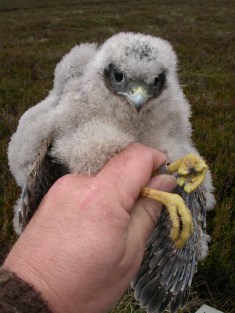Text and images by Mike Nattrass
The Merlin is one of the flagship species of the Northumbria Ringing Group (NRG). One of the longest running raptor studies in the UK, we started monitoring and ringing Merlins as far back as 1961. A second study, in County Durham, now under the auspices of the Durham Upland Bird Study Group (DUBSG), began in 1983.
The overall population of the two counties, which embrace the North Pennine uplands, border forest of Kielder and the Cheviot Hills, is currently in the order of 70 pairs – about 6% nationally. Numbers have declined since the mid 1990’s, but are stable at present.




The 2014 season was one of the most productive for the Merlin in both counties in recent years. Few nest failures were recorded in a second consecutive summer of largely clement weather and plentiful supply of prey. Group members enjoyed ringing 132 of more than 160 young fledging in the region. This brings the total ringed to date to 3882 pullus and 17 full grown birds. Of these, 183 (5%) have been recovered or controlled.


Recovery data shows that the bulk of Northumberland and County Durham Merlin young move in a south to south easterly direction following dispersal from the natal site, mirroring the national trend. Over 50% of birds recovered of all ages were within 100km of their birth place, mostly in lowland areas where they would be wintering. Some went as far as the south coast of England and a handful to France and Iberia.
The breeding ecology of the Merlin in Northumberland is described in papers published in British Birds and Bird Study, whilst the Durham findings are documented in reports of the NRG and DUBSG.


